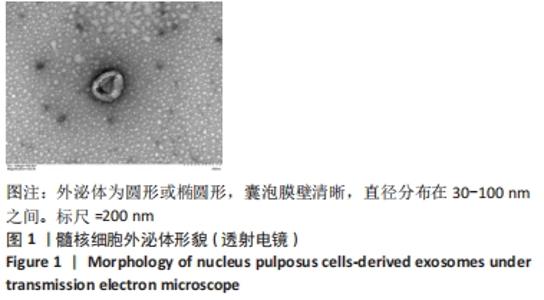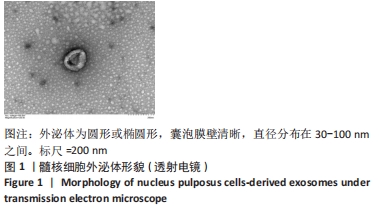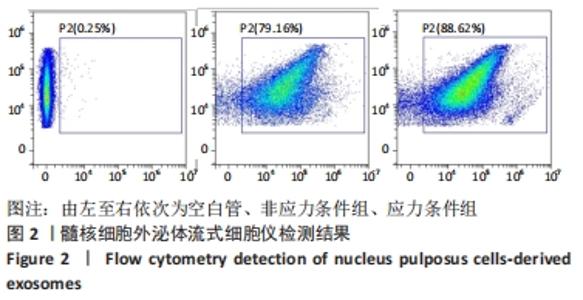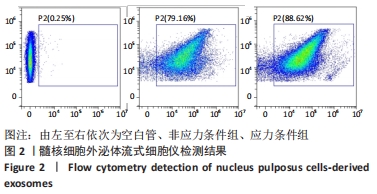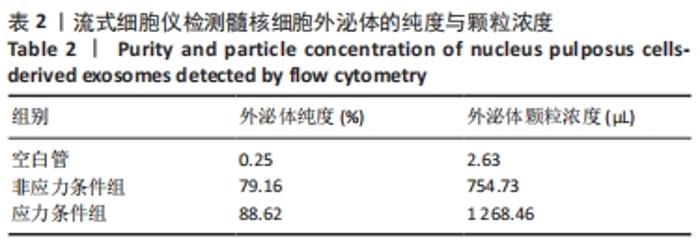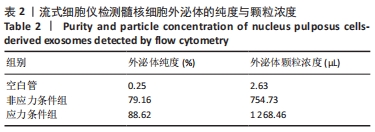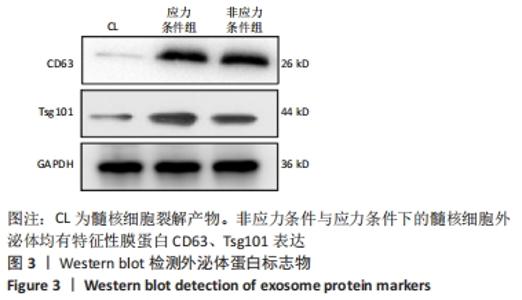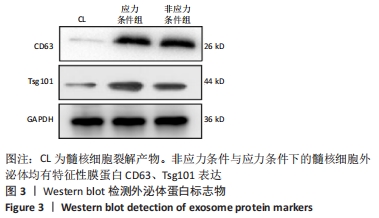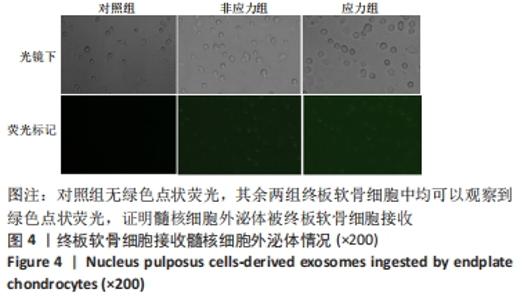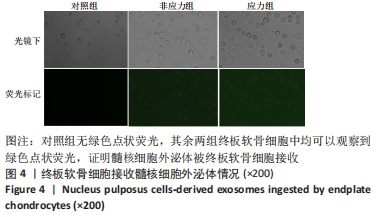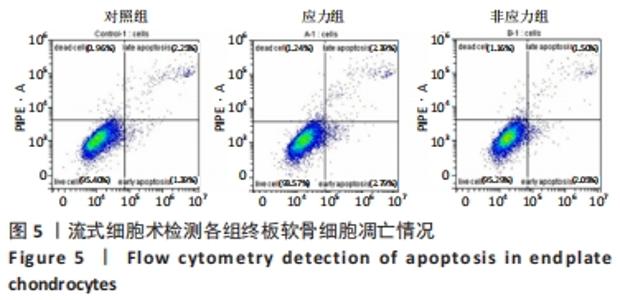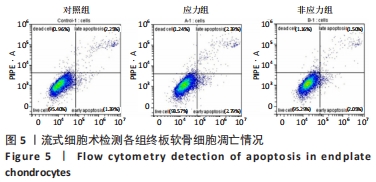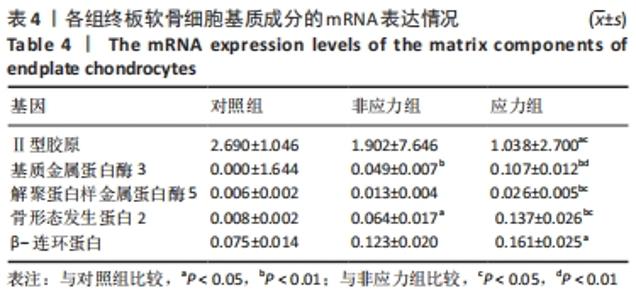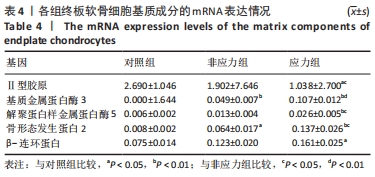Chinese Journal of Tissue Engineering Research ›› 2023, Vol. 27 ›› Issue (2): 223-229.doi: 10.12307/2022.914
Previous Articles Next Articles
Effect of nucleus pulposus cells-derived exosomes under cyclic mechanical tension on endplate chondrocytes
Zhang Weiye1, Zhan Jiawen1, 2, Zhu Liguo2, 3, Wang Shangquan1, 2, Chen Ming1, 2, Wei Xu2, 4, Feng Minshan3, 4, Yu Jie3, 4, Han Tao1, 4, Cai Chuhao1, Zhou Shuaiqi1, Shao Chenchen1
- 1Department of Orthopedics and Traumatology, 3Second Department of Spine, 4Academic Development Department, Wangjing Hospital, Chinese Academy of Traditional Chinese Medicine, Beijing 100102, China; 2Beijing Key Laboratory of Bone Setting Technology of Traditional Chinese Medicine, Beijing 100700, China
-
Received:2021-12-09Accepted:2022-01-28Online:2023-01-18Published:2022-06-18 -
Contact:Zhan Jiawen, Associate chief physician, Department of Orthopedics and Traumatology, Wangjing Hospital, Chinese Academy of Traditional Chinese Medicine, Beijing 100102, China; Beijing Key Laboratory of Bone Setting Technology of Traditional Chinese Medicine, Beijing 100700, China Zhu Liguo, Chief physician, Beijing Key Laboratory of Bone Setting Technology of Traditional Chinese Medicine, Beijing 100700, China; Second Department of Spine, Wangjing Hospital, Chinese Academy of Traditional Chinese Medicine, Beijing 100102, China -
About author:Zhang Weiye, MD candidate, Department of Orthopedics and Traumatology, Wangjing Hospital, Chinese Academy of Traditional Chinese Medicine, Beijing 100102, China -
Supported by:the National Natural Science Foundation of China, Nos. 81930118 (to ZLG), 81774330 (to FMS), and 81804120 (to ZJW); Innovation Team and Talents Cultivation Program of the National Administration of Traditional Chinese Medicine, No. ZYYCXTD-C-202003 (to ZLG); the Fundamental Research Funds for Young Scientific Talents in Chinese Academy of Traditional Chinese Medicine, No. ZZ13-YQ-038 (to ZJW)
CLC Number:
Cite this article
Zhang Weiye, Zhan Jiawen, Zhu Liguo, Wang Shangquan, Chen Ming, Wei Xu, Feng Minshan, Yu Jie, Han Tao, Cai Chuhao, Zhou Shuaiqi, Shao Chenchen. Effect of nucleus pulposus cells-derived exosomes under cyclic mechanical tension on endplate chondrocytes[J]. Chinese Journal of Tissue Engineering Research, 2023, 27(2): 223-229.
share this article
Add to citation manager EndNote|Reference Manager|ProCite|BibTeX|RefWorks
| [1] KELLER TS, HANSSON TH, ABRAM AC, et al. Regional variations in the compressive properties of lumbar vertebral trabeculae. Effects of disc degeneration. Spine (Phila Pa 1976). 1989;14(9):1012-1019. [2] ADAMS MA, DOLAN P. Spine biomechanics. J Biomech. 2005;38(10):1972-1983. [3] KOBAYASHI S, BABA H, TAKENO K, et al. Fine structure of cartilage canal and vascular buds in the rabbit vertebral endplate. Laboratory investigation. J Neurosurg Spine. 2008;9(1):96-103. [4] ZHAN JW, WANG SQ, FENG MS, et al. Effects of Axial Compression and Distraction on Vascular Bud and VEGFA Expression in the Vertebral Endplate of an Ex Vivo Rabbit Spinal Motion Segment Culture Model. Spine (Phila Pa 1976). 2021;46(7):421-432. [5] ZHAN JW, WANG SQ, FENG MS, et al. Constant compression decreases vascular bud and VEGFA expression in a rabbit vertebral endplate ex vivo culture model. PLoS One. 2020;15(6):e0234747. [6] ARUN R, FREEMAN BJ, SCAMMELL BE, et al. 2009 ISSLS Prize Winner: What influence does sustained mechanical load have on diffusion in the human intervertebral disc?: an in vivo study using serial postcontrast magnetic resonance imaging. Spine (Phila Pa 1976). 2009;34(21):2324-2337. [7] HWAN TAK H, YON JIN C, TAN BHM, et al. Vascularization and morphological changes of the endplate after axial compression and distraction of the intervertebral disc. Spine (Phila Pa 1976). 2011;36(7): 505-511. [8] XU H, CHEN X, DING G, et al. Effect of pcDNA3.1-vascular endothelial growth factor 165 recombined vector on vascular buds in rabbit vertebral cartilage endplate. Chin Med J (Engl). 2012;125(22):4055-4060. [9] 曹鑫,宋洁富,荆志振,等.椎间盘退变与微环境改变的研究进展[J].世界最新医学信息文摘,2018,18(43):112-113+116. [11] 路康,杨匡,李海音,等.髓核细胞来源外泌体对骨髓间充质干细胞向髓核样细胞分化的作用[J].中国脊柱脊髓杂志,2016,26(10): 933-938. [12] SUN Z, LIU B, LIU ZH, et al. Notochordal-Cell-Derived Exosomes Induced by Compressive Load Inhibit Angiogenesis via the miR-140-5p/Wnt/β-Catenin Axis. Mol Ther Nucleic Acids. 2020;22:1092-1106. [13] XU HG, HU CJ, WANG H, et al. Effects of mechanical strain on ANK, ENPP1 and TGF-β1 expression in rat endplate chondrocytes in vitro. Mol Med Rep. 2011;4(5):831-835. [14] YANG M, FENG C, ZHANG Y, et al.Autophagy protects nucleus pulposus cells from cyclic mechanical tensioninduced apoptosis. Int J Mol Med. 2019;44(2):750-758. [15] LI S, JIA X, DUANCE VC, et al. The effects of cyclic tensile strain on the organisation and expression of cytoskeletal elements in bovine intervertebral disc cells: An in vitro study. Eur Cell Mater. 2011;21:508-522. [16] ZHENG Q. Intermittent cyclic mechanical tension promotes endplate cartilage degeneration via canonical Wnt signaling pathway and E-cadherin/β-catenin complex cross-talk. Osteoarthritis Cartilage. 2016;24(1):158-168. [17] XIE L, CHEN Z, LIU M, et al. MSC-Derived Exosomes Protect Vertebral Endplate Chondrocytes against Apoptosis and Calcification via the miR-31-5p/ATF6 Axis. Mol Ther Nucleic Acids. 2020;26(22):601-614. [18] LIAO Z, LUO R, LI G, et al. Exosomes from mesenchymal stem cells modulate endoplasmic reticulum stress to protect against nucleus pulposus cell death and ameliorate intervertebral disc degeneration in vivo. Theranostics. 2019;9(14):4084-4100. [19] 李凯明,李玲慧,王尚全,等.补肾活血法改善腰椎间盘突出症患者生存质量疗效评价[J].辽宁中医药大学学报,2020,22(3):42-46. [20] HE J, FENG C, SUN J, et al. Cartilage intermediate layer protein is regulated by mechanical stress and affects extracellular matrix synthesis. Mol Med Rep. 2018;17(4):6130-6137. [21] YANG X. Analysis of the copy number of exogenous genes in transgenic cotton using real-time quantitative PCR and the 2-△△CT method. Afr J Biotechnol. 2012;11(23):6226-6233. [22] 曹鑫,宋洁富,荆志振,等.椎间盘退变与微环境改变的研究进展[J].世界最新医学信息文摘,2018,18(43):112-113+116. [23] 康新桂,吴小涛,时睿,等.椎间盘髓核细胞老化的微环境因素研究现状[J].中国脊柱脊髓杂志,2016,26(4):370-374. [24] 王运涛,吴小涛,王锋,等.过早衰老髓核细胞微环境中BMSCs的生物学行为研究[J].中国修复重建外科杂志,2014,28(6):758-762. [25] LIBO J, FENGLAI Y, XIAOFAN Y, et al. Responses and adaptations of intervertebral disc cells to microenvironmental stress: a possible central role of autophagy in the adaptive mechanism. Connect Tissue Res. 2014;55(5-6):311-321. [26] NEIDLINGER-WILKE C, BOLDT A, BROCHHAUSEN C, et al. Molecular interactions between human cartilaginous endplates and nucleus pulposus cells: a preliminary investigation. Spine (Phila Pa 1976). 2014; 39(17):1355-1364. [27] FENG C, LIU H, YANG M, et al. Disc cell senescence in intervertebral disc degeneration: Causes and molecular pathways. Cell Cycle. 2016;15(13): 1674-1684. [28] 杨骐宁,曹杨,周勇伟,等.Piezo1蛋白在人退变软骨细胞应力模型中的表达特点[J].中国骨伤,2018,31(6):550-555. [29] FENG C, YANG M, ZHANG Y, et al. Cyclic mechanical tension reinforces DNA damage and activates the p53-p21-Rb pathway to induce premature senescence of nucleus pulposus cells. Int J Mol Med. 2018; 41(6):3316-3326. [30] VERGROESEN PP, KINGMA I, EMANUEL KS, et al. Mechanics and biology in intervertebral disc degeneration: a vicious circle. Osteoarthritis Cartilage. 2015;23(7):1057-1070. [31] 王艺儒,梁倩倩,唐德志,等.桃仁-红花药对对动静力失衡性大鼠椎间盘软骨终板细胞老化及凋亡的影响[J].环球中医药,2018, 11(4):497-501. [32] WONG J, SAMPSON SL, BELL-BRIONES H, et al. Nutrient supply and nucleus pulposus cell function: effects of the transport properties of the cartilage endplate and potential implications for intradiscal biologic therapy. Osteoarthritis Cartilage. 2019;27(6):956-964. [33] 常献,周跃,李长青.人软骨终板干细胞与退变髓核细胞体外非接触共培养的实验研究[J].中国脊柱脊髓杂志,2015,25(1):54-61. [34] 马骁,杨学军,霍洪军,等.兔髓核内注射TGF-β_1对退变软骨终板组织形态学影响的实验研究[J].临床骨科杂志,2011,14(6):702-704. [35] 伍耀宏,王长根.髓核退变程度对软骨终板干细胞生物学特性的影响[J].华夏医学,2021,34(5):1-4. [36] LUO L, JIAN X, SUN H, et al. Cartilage endplate stem cells inhibit intervertebral disc degeneration by releasing exosomes to nucleus pulposus cells to activate Akt/autophagy. Stem Cells. 2021;39(4):467-481. [37] KALLURI R, LEBLEU VS. The biology, function, and biomedical applications of exosomes. Science. 2020;367(6478):eaau6977. [38] CHEN X, ZZA D, BFA E, et al. Mesenchymal stem cell-derived exosomes ameliorate intervertebral disc degeneration via anti-oxidant and anti-inflammatory effects. Free Radic Biol Med. 2019;143(1):1-15. [39] 刘明强,陈海伟,张广智,等.外泌体治疗椎间盘退变的研究进展[J].解放军医学杂志,2021,46(8):831-836. [40] KANG L, LI HY, YANG K, et al. Exosomes as potential alternatives to stem cell therapy for intervertebral disc degeneration: in-vitro study on exosomes in interaction of nucleus pulposus cells and bone marrow mesenchymal stem cells. Stem Cell Res Ther. 2017;8(1):1-11. [41] XIANG H, SU W, WU X, et al.Exosomes Derived from Human Urine-Derived Stem Cells Inhibit Intervertebral Disc Degeneration by Ameliorating Endoplasmic Reticulum Stress. Oxid Med Cell Longev. 2020;2020(7):6697577. [42] SONG J, CHEN ZH, ZHENG CJ, et al. Exosome-transported circRNA_0000253 competitively adsorbs microRNA-141-5p and downregulates SIRT1 to increase intervertebral disc degeneration. Mol Ther Nucleic Acids. 2020;4(21):1087-1099. [43] LI S, JIA X, DUANCE VC, et al. The effects of cyclic tensile strain on the organisation and expression of cytoskeletal elements in bovine intervertebral disc cells: an in vitro study. Eur Cell Mater. 2011;20(21): 508-522. |
| [1] | Zhang Lichen, Chen Liang, Gu Yong. Inorganic ion bionic periosteum regulates immune microenvironment to promote bone repair [J]. Chinese Journal of Tissue Engineering Research, 2023, 27(3): 346-353. |
| [2] | Lan Qian, Gu Yangcong, Xiao Xin, Bi Xueting, Li Na. Human periodontal ligament stem cells-derived exosomes interfere with the proliferation and differentiation of MC3T3-E1 cells [J]. Chinese Journal of Tissue Engineering Research, 2023, 27(1): 54-58. |
| [3] | Liu Runyuan, Dong Ming, Han Wenqing, Dong Juhong, Niu Weidong. Application and progress of small extracellular vesicles in periodontal and pulp regeneration [J]. Chinese Journal of Tissue Engineering Research, 2023, 27(1): 83-90. |
| [4] | Liu Zhuoran, Jiang Ming, Li Yourui. Extracellular vesicles in chronic periodontitis [J]. Chinese Journal of Tissue Engineering Research, 2023, 27(1): 99-104. |
| [5] | Zhu Zhenghuan, Zou Hongjun, Song Zhiwen, Liu Jinbo. Cellular microenvironment in nerve repair after spinal cord injury [J]. Chinese Journal of Tissue Engineering Research, 2023, 27(1): 114-120. |
| [6] | Guo Yujun, Lu Wenjun, Yang Shulong, Li Zhaozhu. Effect of urine-derived stem cells and their exosomes on kidney diseases [J]. Chinese Journal of Tissue Engineering Research, 2023, 27(1): 138-144. |
| [7] | Liu Wentao, Feng Xingchao, Yang Yi, Bai Shengbin. Effect of M2 macrophage-derived exosomes on osteogenic differentiation of bone marrow mesenchymal stem cells [J]. Chinese Journal of Tissue Engineering Research, 2022, 26(在线): 1-6. |
| [8] | Zhang Haobo, Zhao Yunan, Yang Xuejun. Role and therapeutic implications of pyroptosis in intervertebral disc degeneration [J]. Chinese Journal of Tissue Engineering Research, 2022, 26(9): 1445-1451. |
| [9] | Hu Wei, Xie Xingqi, Tu Guanjun. Exosomes derived from bone marrow mesenchymal stem cells improve the integrity of the blood-spinal cord barrier after spinal cord injury [J]. Chinese Journal of Tissue Engineering Research, 2022, 26(7): 992-998. |
| [10] | Wu Weiyue, Guo Xiaodong, Bao Chongyun. Application of engineered exosomes in bone repair and regeneration [J]. Chinese Journal of Tissue Engineering Research, 2022, 26(7): 1102-1106. |
| [11] | Zhou Hongqin, Wu Dandan, Yang Kun, Liu Qi. Exosomes that deliver specific miRNAs can regulate osteogenesis and promote angiogenesis [J]. Chinese Journal of Tissue Engineering Research, 2022, 26(7): 1107-1112. |
| [12] | Zhang Jinglin, Leng Min, Zhu Boheng, Wang Hong. Mechanism and application of stem cell-derived exosomes in promoting diabetic wound healing [J]. Chinese Journal of Tissue Engineering Research, 2022, 26(7): 1113-1118. |
| [13] | Hou Wanxing, Li Hongwei, Zheng Xin, Zhu Xianren. Correlation between preoperative magnetic resonance imaging findings and bone cement leakage after percutaneous vertebral augmentation [J]. Chinese Journal of Tissue Engineering Research, 2022, 26(4): 504-509. |
| [14] | He Guanyu, Xu Baoshan, Du Lilong, Zhang Tongxing, Huo Zhenxin, Shen Li. Biomimetic orientated microchannel annulus fibrosus scaffold constructed by silk fibroin [J]. Chinese Journal of Tissue Engineering Research, 2022, 26(4): 560-566. |
| [15] | Kou Bowen, Han Ye, Hao Yiguang, Xu Haoxiang, Wen Wangqiang, Zhang Zepei, Lan Jie, Miao Jun. Morphological changes and strain characteristics of lumbar intervertebral disc during sitting in forward flexion [J]. Chinese Journal of Tissue Engineering Research, 2022, 26(36): 5792-5797. |
| Viewed | ||||||
|
Full text |
|
|||||
|
Abstract |
|
|||||
